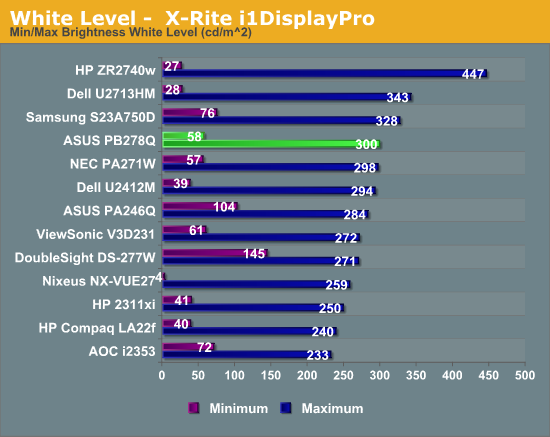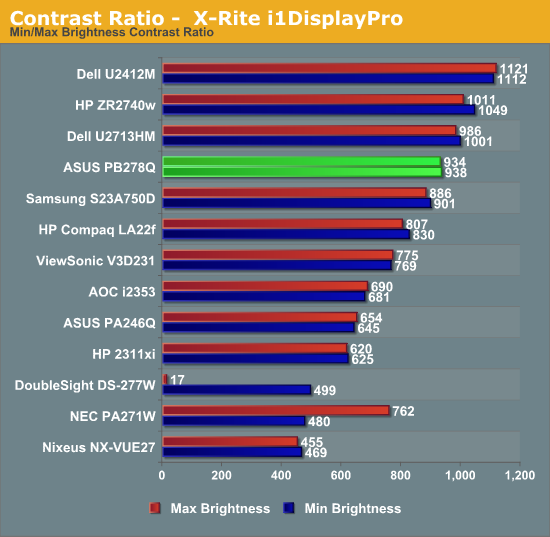ASUS PB278Q Review: An IPS Competitor Emerges
by Chris Heinonen on November 19, 2012 11:00 PM ESTASUS PB278Q Brightness and Contrast
ASUS says that the PB278Q can do 300 nits at maximum brightness, and that spec hits it right on the head. With a full white screen and the brightness pushed up all the way, I got exactly 300 nits of light output from the display. One of PLS' advantages over IPS is supposed to be the ability to let more light through, though this number is very close to what other 27” displays achieve. It might be able to do this using a lower powered LED backlight, and we will test that out in power usage later to see if that is the case.
With the brightness at minimum, we get 58 nits of brightness which should be low enough for virtually every user. The lowest that most users might set a display to is probably 80 nits, and so as long as a display goes below that level I think that is a perfectly acceptable minimum brightness level. This range from 58 to 300 should also accommodate virtually all users for their brightness requirements.

Before measuring the black level, I made sure to disable dynamic contrast, as it would likely just disable the LED backlight and give a result of 0 for a black screen. Since no one really uses an all black screen in this way, I don’t feel that testing it is appropriate. With the backlight at maximum the black level was 0.32 nits, and at minimum it was down to 0.062 nits. This is a decent minimum black level for a display, and good for IPS, but not as exceptional as some displays can manage.

The black level looks better when used to calculate the contrast ratio of the display here. With a contrast ratio right around 935, this is right around what we see for other 27” IPS displays. The PLS display seems to be equal to what other IPS displays can manage, not really much better or worse, but right down the middle of the range.

Brightness and Contrast details are right in line with what we expect from an IPS display, and since PLS is very similar to IPS we see very similar results. The peak brightness is lower than some IPS displays, but most people don’t use more than 300 nits and we will see later if this enabled ASUS to use a lower power backlight.










55 Comments
View All Comments
praeses - Monday, November 19, 2012 - link
Can you get the PWM frequency used for the backlight? If its variable, then at 25%, 50%, and 75% brightness levels?DaFox - Tuesday, November 20, 2012 - link
PWM frequency is very important to me as well these days.martyrant - Tuesday, November 20, 2012 - link
+1WoodyPWX - Wednesday, November 21, 2012 - link
That's why I bought the Dell U2713HM. It doesn't use PWM at all => no visible flickering. My eyes are very sensitive to that.p05esto - Tuesday, November 20, 2012 - link
I would like some opinions on does PWM matter? I sit in front of a screen ALL day and most nights. Does PWM matter to my eyes and ability to stay focused? I think my currentl monitor uses PWM (I tried the camera test, just roughly but I saw lines).Death666Angel - Tuesday, November 20, 2012 - link
Huh? Only you can answer that question. If you don't have trouble with a monitor with a PWM back lighting, then it obviously doesn't matter to you. Great article about it: http://www.prad.de/en/monitore/specials/backlight.... And they test PWM frequency with every monitor they get nowadays. :)gevorg - Tuesday, November 20, 2012 - link
Checkout this article on how to measure PWM of your monitor:http://www.tftcentral.co.uk/articles/pulse_width_m...
demonbug - Wednesday, November 21, 2012 - link
Interesting. Discovered mine is at 240 Hz, which would explain why I get that flickering feeling (it's a cheap TN panel with an LED backlight, so not surprising). I'll have to try running it at higher brightness and see if that helps.Oxford Guy - Tuesday, November 20, 2012 - link
Eyestrain isn't always easy to detect.The bottom line is that there are PWM-free panels now and they simply don't flicker.
A cheap way to stop PWM flicker is to turn a PWM monitor to full brightness. A TN panel can be tilted vertically to make the brightness more bearable. But, it's better, of course, to get a constant control backlight.
jjj - Monday, November 19, 2012 - link
not bad not great so it comes down to price and that's not all that attractive.You should see if you can get your hands on that extra wide 29 inch Dell,they started selling it at 699$ (it can be had for 630 with a code atm).